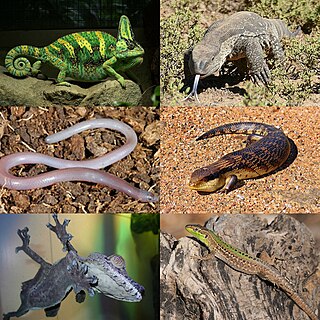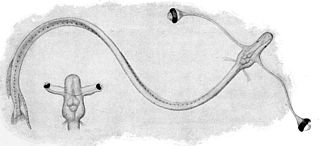 W
WAspius is sometimes considered a genus of Eurasian cyprinid fish, with two recognized species. Both species are now usually included in the genus Leuciscus. They live in depths of water at a minimum of 10 m (33 ft.), at 4 to 20 °C. These fish grow to a maximum of 120 cm (3.9 ft.) long and weigh no more than 12 kg (26 lb.) and live up to 11 years. Aspius species have 7–9 dorsal soft rays and 12–15 anal soft rays. Their long bodies have a long, sharp head. They have a green back with a silver/blue tint with a silver/white belly. Their pectoral, pelvic, and anal fins are grey and brown.
 W
WAvicephala is a possibly polyphyletic and therefore disused taxon of diapsid reptiles that lived during the Late Permian and Triassic periods. Many species had odd specialized grasping limbs and prehensile tails, adapted to arboreal lifestyles.
 W
WFish are gill-bearing aquatic craniate animals that lack limbs with digits. They form a sister group to the tunicates, together forming the olfactores. Included in this definition are the living hagfish, lampreys, and cartilaginous and bony fish as well as various extinct related groups.
 W
WLizards are a widespread group of squamate reptiles, with over 6,000 species, ranging across all continents except Antarctica, as well as most oceanic island chains. The group is paraphyletic as it excludes the snakes and Amphisbaenia; some lizards are more closely related to these two excluded groups than they are to other lizards. Lizards range in size from chameleons and geckos a few centimeters long to the 3 meter long Komodo dragon.
 W
WSalmothymus is a genus name of fish in the family Salmonidae, established for the Adriatic trout. More commonly, however, the species is considered a member of the wider genus Salmo, i.e. Salmo obtusirostris. Salmothymus thus is a junior synonym of Salmo, not in current use.
 W
WStylophthalmus was a name used for what was previously believed to be a genus of fish with eyes perched upon periscopic stalks, known in some cases to be almost one third of the length of the animal's actual body. It is now recognised that all species in this genus are the fish larvae of already named, distantly related fish in the orders Stomiiformes and Myctophiformes which may have developed this same trait as a result of convergent evolution. Thus, Stylophthalmus is an invalid name.
 W
WThecodontia, now considered an obsolete taxonomic grouping, was formerly used to describe a diverse "order" of early archosaurian reptiles that first appeared in the latest Permian period and flourished until the end of the Triassic period. All of them were built somewhat like crocodiles but with shorter skulls, more erect pose and usually somewhat lighter. The group includes the ancestors of dinosaurs, pterosaurs, and crocodilians, as well as a number of extinct forms that did not give rise to any descendants. The term thecodont is still used as an anatomical description of the tooth morphology seen in these species and others.